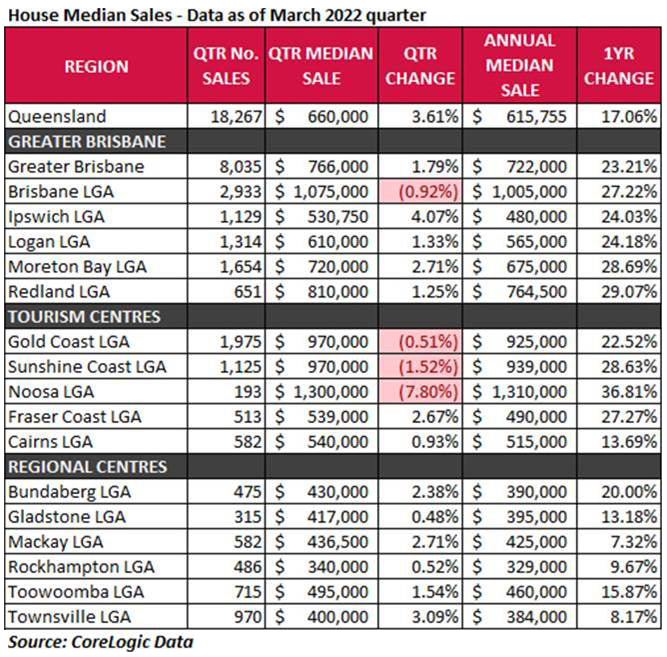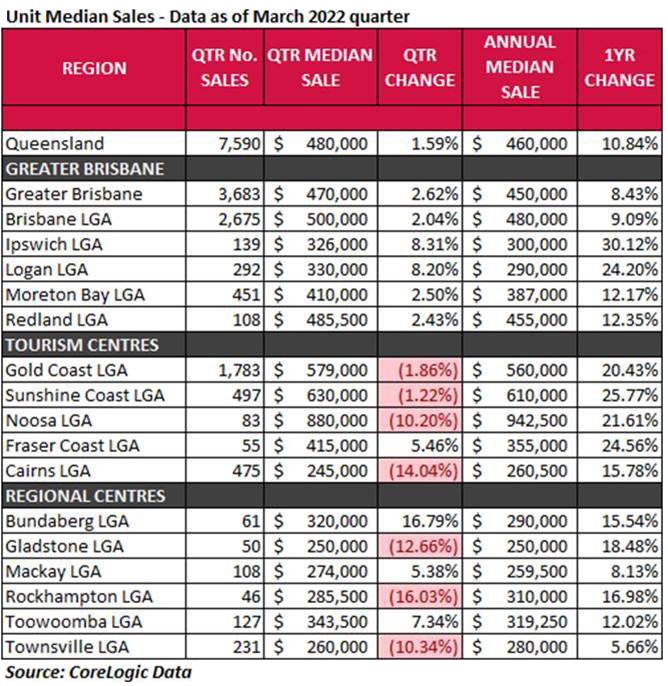Queensland real estate market still has a steady pulse
Speculation surrounding the health of the Queensland property market may have been too quick to diagnose it as in decline, with the latest quarterly sale results showing many areas still in a growth phase.
Property prices continue to rise across Queensland, albeit at a more modest pace, according to quarterly median sales results released by the Real Estate Institute of Queensland (REIQ) on Thursday (25 August).
The June 2022 quarter (April – June 2022) revealed that Queensland’s median house prices rose by 3.61 per cent, while median unit prices still inched up by 1.59 per cent.
REIQ CEO Antonia Mercorella said the latest quarterly results showed Queensland’s soaring property market growth has started to show signs of calming.
“You only need to take a look at the rate of price growth over the past year, with some areas achieving an incredible 20-30 per cent growth year on year, to realise the property market couldn’t keep up that accelerated pace forever,” Ms Mercorella said.
“This quarter we’re still seeing healthy growth in most major markets, but at a more sustainable level, as Queensland’s property market appears to finally have caught up on the growth it was well overdue for.
“What this means on the ground is that the property buying frenzy has relaxed, allowing a slower, more considered approach from buyers which is evidenced by longer days on market.
“Our member agents tell us that demand for property is still energised due to low levels of supply and continued demand, but that there’s price points and property characteristics that buyers are pursuing, including a renewed interest in units and townhouses.
“Honestly, it’s good to see some sense of calm returning to the market, taking buying activity from madness to measured, where both agents and buyers can take a breath.
“The rise of risky behaviours such as buying sight unseen, impossibly short settlement periods, and waiving cooling off periods are hopefully behind us now.”
Ms Mercorella said Queensland’s property market remained resilient despite recent hits to hip pockets and borrowing constraints.
“Consecutive interest rate rises and inflation are seeing households tightening their belts, however this is against the backdrop of very low unemployment, pent up wage growth expectations, continued high interstate migration, an extremely tight rental market, and the return of international migration further boosting our state’s population,” she said.
“These are all factors that will buoy Queensland property prices, and should give buyers confidence in investing in our state.
“We know that smart property investment is about the long-distance run rather than a short sprint, but there’s no doubt that property owners have lapped up Queensland’s extraordinary growth spurt.
“What the Queensland property market has proven over the years is that it pays to get your foot in the market and be in the race.”
House sales market
The Brisbane Local Government Area (LGA) median house price remained steady, experiencing a slight fluctuation to $1,075,000 over the June quarter (March quarter was $1,090,000).
Despite the slowdown during the quarter, year-on-year growth shows the Brisbane LGA annual median sale price was pushed over the million-dollar mark, now sitting at $1,005,000. In fact, Brisbane LGA’s annual growth rate actually rose an impressive 27.22 per cent, demonstrating that a longer outlook reveals a bigger picture of a market performing strongly.

Brisbane suburbs joining the ‘million-dollar median house club’ based on sales in this quarter alone include Mitchelton, Chermside West, Ferny Grove, and Everton Park, while Bulimba just cracked the $2 million mark ($2,001,550).
Expanding out to the Greater Brisbane region, there’s modest positive growth of 1.79 per cent over the quarter to $766,000 based on just over 8,000 sales.
The most affordable LGA in Greater Brisbane is Ipswich LGA ($530,750), which stood out with the top growth rate of 4.07 per cent this quarter, suggesting there’s strong demand in the market for value and greater affordability. Another standout when looking at annual growth was the Redlands, with an incredible 29.07 per cent increase compared to the year prior.
Queensland’s regional centres’ quarterly median house prices rose modestly, but remained under half a million dollars in Rockhampton ($340,000), Townsville ($400,000), Gladstone ($417,000), Bundaberg ($430,000), Mackay ($436,000), and Toowoomba ($495,000), again offering greater affordability.
Taking a dip
Some of the state’s popular tourism centres however, which have had quarter after quarter of steep growth, posted median house sales that dipped compared to the previous quarter of phenomenal performance.
For example, Noosa, which had median house prices growing an astronomical 15.38 per cent in the March quarter, fell 7.80 per cent this quarter – which is understandable given this double-digit growth is a hard act to follow. Noosa maintained its title as the highest quarterly and annual median sale price at $1.3 million, continuing to extraordinarily outperform the capital city, following eye-watering year-on-year growth of 36.81 per cent.
Similarly, the Sunshine Coast LGA reflects this comparative quarterly dip in otherwise a stellar year of performance of 28.63 per cent, stepping back 1.52 per cent to a $970,000 median house price.
The Gold Coast’s median house price also experienced a slight fluctuation, down 0.51 per cent to $970,000, but this is within what is considered steady, and again, follows an extensive period of upward growth.
Fraser Coast LGA continued to have a strong rising housing market this quarter (with 2.67 per cent growth to $539,000), while Cairns LGA’s median house price remained fairly steady (with a 0.93 per cent uptick to $540,000).
Unit sales market
When looking at median unit prices it’s important to remember that the data tends to be more volatile due to lower volume of sales over the quarterly period, however similar median price trends to the house sales market were observed in holiday unit markets.
The Gold Coast retreated by 1.86 per cent, Sunshine Coast dipped 1.22 per cent, and Noosa fell 10.20 per cent, but Noosa’s quarterly result was based on a smaller sale sample size of 83.
However, these markets all experienced excellent growth of over 20 per cent over the past 12 months. Despite the dip over the quarter, annual growth shows the Gold Coast LGA achieved 20.42 per cent, Sunshine Coast LGA reached 25.77 per cent, and Noosa LGA clocked a 21.61 per cent increase.

In the regions, Rockhampton LGA (-16.03 per cent based on just 46 sales), Cairns LGA (-14.04 per cent), Gladstone LGA (-12.66 per cent based on just 50 sales), and Townsville LGA (-10.34 per cent) all posted falling unit median prices – but some of these markets tend to bounce up and down due to smaller volume of unit sales.
For example, in the March quarter Gladstone posted positive growth of 18.37 per cent, which swung downwards 12.66 per cent in the June quarter.
In Greater Brisbane, median unit prices were on the rise, with the most affordable markets - Ipswich LGA ($326,000) and Logan LGA ($330,000) - achieving the highest quarterly growth at 8.31 per cent and 8.20 per cent respectively. These markets also hold some of the highest annual growth in the state with Ipswich soaring an incredible 30.12 per cent and Logan an impressive 24.20 per cent this year.
Brisbane LGA’s median unit price cracked half a million dollars this quarter, with the Redlands hot on its heels with a median unit price of $485,500.


















